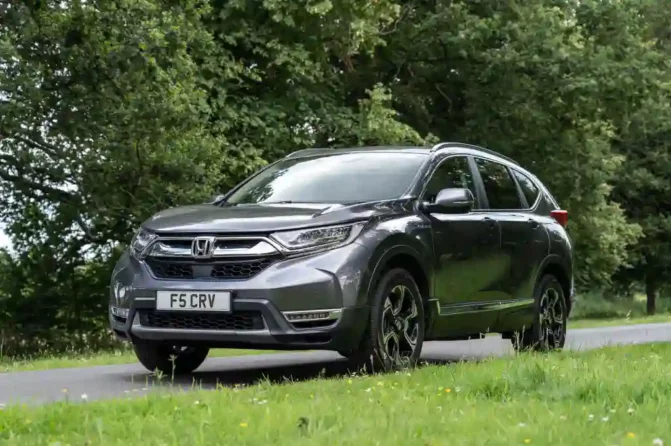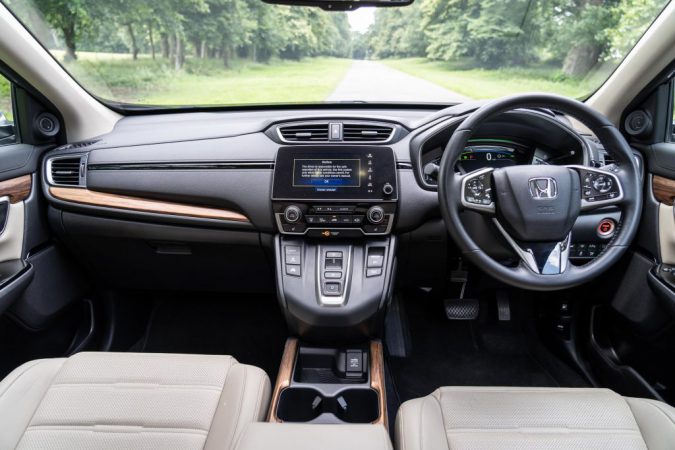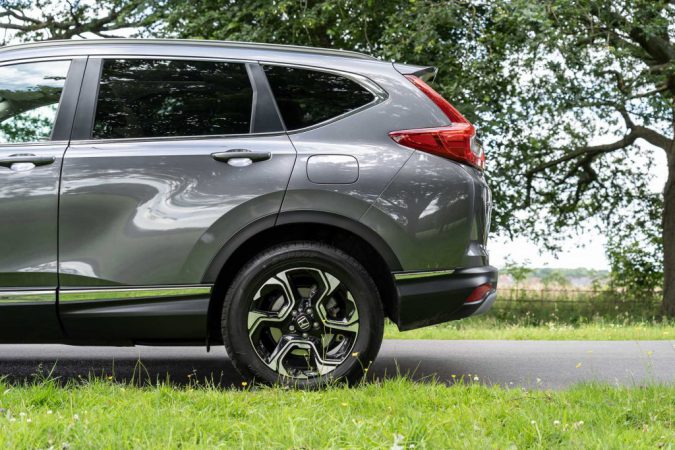Are you in the market for a used compact crossover? The Honda CR-V is probably one of your top picks since Honda is one of the leading carmakers in this segment. And you probably want to learn more about the 2016 Honda CRV problems. Are there some serious issues with this model or not? We are about to find out.
- Background Of The Honda CRV
- CR-V Specs
- 2016 Honda CR-V Common Problems
- 1.5 Engine Problems
- 2.0 Engine Problems
- 2.4 Engine Problems
- Transmission Problems
- Safety Record
- Final Conclusion
When buying a used vehicle, good market research should be one of your top priorities. You need to be informed about the vehicle before you buy. Buying without proper research is a mistake that many people make. They buy the car and later learn about the problems. This makes the ownership experience pretty terrible because people often get a basket case full of issues.
That’s why it is great that you decided to do some research and read our article on the 2016 Honda CRV problems. When you know the problems, you know what you can expect from the car. Also how big can be the repair bills for some of the vehicles? That’s how you can plan your budget ahead, and always be safe from paying enormous repair bills.
In this article, we will learn everything when it comes to the 2016 Honda CRV problems. We will start from the basics to learn more about this model and its history. Then we will discuss the specs and trims that were offered. After that, we are going to learn more about the 2016 Honda CRV problems, and what you can expect when getting a used CRV. Lastly, we are going to discuss if it’s worth it to get one or not. So, let’s dive into the article.
Honda CRV
The CR-V, as we said, is a small compact crossover SUV vehicle manufactured by Honda. It basically uses the Honda Civic platform but with an SUV body. The CR-V stands for Comfortable Runabout Vehicle.
The CR-V has been produced for more than 25 years and this tells a lot about the longevity, popularity, and reliability of this crossover. The North American production is based in Ohio, as well as Ontario, Canada, and Greensburg, Indiana. So, the CR-V can be considered an American product.
There is a total of 5 generations of the CR-V. But we are going to stick with the fifth generation because this article is about the 2016 Honda CRV problems. In order not to confuse you with other Honda CR-V models, we are going to discuss only the fifth generation.
This fifth generation of the CR-V started its production in 2016 and is still being produced to this day.
The CR-V 5 generation is one of the most popular small SUVs on the market right now and is getting more than 300,000 yearly sales steadily in the US since 2016. Making it one of the best-selling vehicles for sale at the moment. In 2019, Honda sold 379,013 CR-Vs and that tells a lot about its popularity.
But enough talk about the admiration for this model. Now, let’s discuss the specs of the CR-V. And later, we are going to cover all the 2016 Honda CRV problems and as well the ownership experiences with the model.
Honda CR-V Specs
The Honda CR-V, as we said, is a compact crossover that is built on the Honda Civic platform. It is a perfect fit if you live in a tight space and you don’t have a lot of room to park your vehicle.
The wheelbase of the CR-V is only 104,7 inches and the overall length is 180.5 inches and it weighs between 3,307 and 3,512. The AWD model is a bit on the heavier side because of the components that make the AWD possible.
As we mentioned, there are FWD versions and AWD versions. The FWD CR-V is also cheaper because it includes fewer components. If you don’t plan to go on rugged terrains, the FWD version will be enough for you. If you plan to drive off-road, you may consider the AWD variant.
In terms of engines, the CR-V has plenty to offer. With five petrol and one diesel engine. The petrol engines are the 1.5 turbo, the 2.0 and 2.4 naturally aspirated engines, and two engines for the hybrid versions. A petrol hybrid system using a 2.0 engine and a plug-in hybrid 2.0 gasoline engine. The most popular of the bunch is the 2.4 liter which we are going to cover later in detail when we are going to discuss the 2016 Honda CR-V problems.
There is also one electric motor that is used on the hybrid variants. The diesel engine is a 1.6 liter turbocharged 4 cylinders.
In the transmission department, the CR-V has also a lot to offer with its CVT transmission. And we are going to cover that later in great detail.
There is also a 9-speed automatic transmission with a torque converter that most car owners would prefer.
2016 Honda CRV Problems
In this chapter, we are going to cover the most common problems with the CR-V and what are the ways that these problems can be tackled quickly and effectively. This will be out of great help to people who are in the market for a used Honda CR-V and want to learn about the 2016 Honda CRV problems. So, without further ado, let’s dive into the problems of the CR-V.
2016 Honda CR-V Engine Problems
In this first chapter, we are going to cover all the problems with most of these engines that the CR-V uses for you to understand which engine is your best bet.
1.5 Straight 4 Engine
The 1.5 is the entry-level engine in the CR-V lineup and is most frequently included in the base models of the CR-V.
2016 Honda CRV Problems #1: Over-Dilution Of Oil And Fuel
This is one of the most common problems with the small 1.5 turbo engine. Many owners have reported a gas odor in their cabins.
These problems were reported in some states where the weather is not particularly nice to the cars and during the extremely cold winter, this problem can start to appear.
This problem is created by excess fuel that hasn’t been able to vaporize in the combustion chamber. And this problem is causing the oil lubricity to dilute and this can potentially damage the engine and cause all sorts of issues. Namely engine misfiring, power loss, stalling of the engine, and even limp mode in some serious cases.
The fuel is basically mixing with the oil and reduces the lubricity characteristics of the oil and causes the components inside of the engine to wear down prematurely. This is one of the most common 2016 Honda CRV problems. Honda has released new engine software that will make the engine get up to temperature quicker than with the previous software.
Also, more frequent oil changes will make sure that your 1.5 turbo engine is safe and sound and will last for a long time.
2016 Honda CRV Problems #2: No Heating In The Cabin
Some owners have reported that their CR-V did not produce any or it produced little heat during the cold winter days. This resulted in the drivers driving in undrivable conditions.
Many owners have reported this problem and Honda acknowledged the issue. They made some changes to these affected cars. They updated the software and also replaced the heater cores on the vehicles that were affected with new and updated heater units that heated up the vehicle.
There are still some claims that even after these updates, drivers are feeling cold while they are driving their CR-V. That’s why if you live in a state that has cold weather during most of the year, maybe the best solution is to go for a bigger engine that will deliver enough power to heat up the car.
2016 Honda CRV Problems #3: Carbon Buildup In The Engine
Since the 1.5 is a direct injection engine, the carbon buildup on the intake valves is a common occurrence. The direct injection just works that way and produces a lot of carbon deposits. Unfortunately, there is no way around it.
The carbon buildup symptoms can include frequent misfires and power loss. If the valves are damaged, they can even not seal properly and the engine can lose compression and feel underpowered. If this is the case, you are in trouble and this repair can be costly.
But luckily for you, there are a lot of services that offer carbon cleaning and you can clean your heads. This process is called walnut blasting and during this process, all the carbon deposits from the intake manifold and the engine head are cleaned, so the intake valves can function properly once again.
2016 Honda CRV Problems #4: Spark Plug Failure
The carbon buildup and the oil dilution issues are affecting the spark plugs as well. Under these conditions, the spark plugs tend to fail more often than usual and you will have to replace them more frequently than in other vehicles.
Symptoms of bad spark plugs, as we said, are carbon buildup, rough idle, and stutter. Misfires are also another frequent symptom when the spark plugs are bad.
It is fortunately for you, as an owner, that these spark plugs are fairly cheap and inexpensive. They can be replaced easily and you will not have issues with misfires for a while.
2.0 Straight 4 Engine
The 2.0 engine is a really reliable engine and one of Honda’s best engines. This engine could easily go up to 180,000 miles with no issues whatsoever.
The biggest problems with these engines are the noises and vibrations that they produce.
2016 Honda CRV Problems #5: Knocking Sound
The EVAP canister is notorious for producing this sound on the 2.0 engines. This sound is considered a normal occurrence and you don’t have to worry about it. If the sound is metallic and comes from the cylinders you may also have a rod knock issue on your car. This problem will require addressing the issue of replacing the whole engine if the damage is too significant.
2016 Honda CRV Problems #6: Noise Coming From The Pulley
Another problem is the noise that the engine pulley is making. This pulley is moving the accessory belt. These pulleys can start wobbling after 100,000 miles and they need to get changed. When you are changing the pulley, you can also change the drive belt and the tensioner to make your engine drive with no issues. This repair can cost you between $400 and $800 depending on where you take your car to get it fixed.
2016 Honda CRV Problems #7: Vibrations
Vibrations are another issue that this engine has. These vibrations often appear on engines that are far beyond 150,000 miles. This problem can be attributed to the worn engine mounts.
The engine mounts are the components on which the engine is placed and attached. They tend to wear and develop issues like vibrations in the cabin. The simple solution for this problem is replacing the engine mounts with new ones and you are good to go.
2.4 Straight 4 Engine
The 2,4 engine is also known as the K24 engine is one of Honda’s most popular engines around. And the big production numbers also mean some problems with this engine as well. So, what are the 2016 Honda CRV problems that affect the K24 engine? Let’s find out.
2016 Honda CRV Problems #8: Front Main Seal Oil Leak
The main seal oil leak or crankshaft seal leak is widespread in K24 engines. This problem is caused by a bad crankshaft seal. This seal basically stops the oil from escaping from the engine and unfortunately, it can fail.
This seal is located on the front, this means that this seal is on the left side where the belts are placed. At the bottom is the main pulley, and behind this pulley is located the seal.
To access the seal, the accessory belt has to be replaced as well as the pulley. This job is relatively easy since the K24 engines have a lot of space to work on.
This seal usually fails above 120,000 miles, but as the car gets older, these rubber components become hard and could cause leaks.
Visible symptoms are the low oil level and the splashes of oil under the hood or under the car. This problem can be serious. If you do not monitor the level of oil in your engine, you will probably end up with a low amount of oil. And there will possibly be significant engine damage caused by this lack of oil.
When you notice this problem, the best thing to do is to take action right away and take your car to a mechanic. Or, if you cannot manage to do this job quickly, always monitor your oil levels.
2016 Honda CRV Problems #9: Wear On The Camshaft Lobes
Wear of the camshaft or galling of the lobes as it is most known is a common issue on the K24. This problem is very frequent on this engine and the problem is caused by excessive friction of the cam lobes.
This problem mostly happens due to a lack of oiling and improper and irregular maintenance on the engine. The cam lobes basically are left without lubrication, and they start to create friction, and this friction will going to trash your camshaft.
The only solution for this problem is replacing the camshaft with a new one. That’s because the cam is too damaged to continue working as it should. And this replacement can cost a lot of money to be done. Between $800 and $1500 to be more exact.
But it’s worth noting that this problem is not that frequent in the 2016 Honda CRV problems, and the chances that it can happen to you are very rare. This happens only to engines that are poorly maintained with a lot of sludge inside that does not allow the oil to go up and lube the camshaft.
Symptoms of this problem are the ticking sound and the reduced oil pressure.
2016 Honda CRV Problems #10: Timing Chain Tensioner Problems
The 2.4 is a timing chain-driven engine, this in other words translates in less often replacements of the timing chain, but a more expensive procedure.
The problem, like with almost all timing chain-driven engines, lies in the timing chain tensioners. These tensioners are poorly made plastic parts that manufacturers install in their cars. When they break, they can cause the chain to jump. This jumping will cause you some engine damage, that is bent valves and other damage to the cylinder wall. It can basically trash your block and you will have to replace the whole engine in the worst case.
It is good to act quickly when the tensioners are loose and the chain starts to rattle. The longer you wait and drive your car, the worse it becomes. The best thing you can do is take your car to a mechanic right away.
And since you are at the mechanic’s shop, it is a good idea to replace the chain as well. This job is going to be pricey. It’ll cost you between $800 and $1200 for the whole job with the timing chain and the tensioners.
This is considered as one of the pricier 2016 Honda CRV problems. This is the case because a lot of components need to be removed and this can add up the costs overall.
2016 Honda CR-V Transmission Problems
We have covered all the engine issues with the CR-V and now let’s see which are the 2016 Honda CRV problems connected with the transmission.
Unlike other brands such as Jeep or Nissan that make unreliable CVT transmissions, Honda’s CVTs are actually good. They don’t have a lot of issues and they can be regarded as one of the components that will make your Honda ownership a breeze.
But it is worth noting that its worth noting that these transmissions create noise sound when you accelerate on the throttle, and also produce sounds while on lower speed.
The CVT transmissions are also much more expensive than the regular torque converter automatics to rebuild or replace. So, if you have a bad CVT transmission, it’s going to cost you a few grand to fix.
The ZF 9-speed transmission is also a reliable transmission without any major problems. These transmissions are widely used in many products on the market and deliver excellent performance.
2016 Honda CRV Problems #11: Infotainment System Issues
Numerous owners have raised concerns regarding the infotainment system. Some faced challenges with the touchscreen being unresponsive or glitches that caused the system to reset or freeze randomly. This could be particularly frustrating when relying on navigation or trying to control audio settings during a drive.
Honda did offer software updates to address these problems, but not all users found them effective. It’s advisable to regularly check for updates and consult with your dealership to see if any recalls or fixes are available.
2016 Honda CRV Problems #12: Transmission Hesitation
Another matter of concern was the CVT (Continuously Variable Transmission) which exhibited occasional hesitation or delay in acceleration. Some drivers noted a lag between stepping on the gas pedal and the vehicle accelerating. Such hesitation can be concerning, especially when merging onto highways or during situations requiring quick speed adjustments.
Regular transmission checks and fluid changes can help. But if you notice such hesitations, it’s good to get a thorough check-up to ensure safety.
2016 Honda CRV Problems #13: Brake Wear and Squeaking
Some owners found their brake pads wearing out sooner than anticipated. Alongside this, there were occasional reports of squeaking brakes even after replacements. Regular inspections and prompt replacement of worn components are key. However, it’s equally important to ensure that high-quality parts are used to avoid frequent wear and potential safety risks.
2016 Honda CRV Problems #14: Battery Drain Issues
A few 2016 CR-V owners faced unexpected battery drains. Some found their car batteries dead after the car sat idle for a couple of days. While batteries naturally degrade over time, such sudden drains indicate possible underlying electrical issues. It’s wise to get a comprehensive electrical check if you face this problem.
2016 Honda CRV Problems #15: A/C Compressor Failures
Air conditioning problems have been reported, with some users noting that the A/C compressor failed, leading to inadequate cooling. Given the importance of A/C, especially during hot summers, any signs of reduced cooling efficiency should prompt a visit to a trusted mechanic. Remember, a malfunctioning A/C system can also impact fuel efficiency.
2016 Honda CRV Problems #16: Wheel Alignment and Tire Wear
Improper wheel alignment or uneven tire wear has been another issue for some CR-V drivers. This not only affects the ride quality but also poses safety risks and reduces fuel efficiency. Regular wheel alignments and tire rotations, alongside keeping an eye out for uneven wear patterns, can help tackle this issue.
Despite these concerns, it’s worth noting that the 2016 Honda CR-V remains a popular SUV choice for many, known for its reliability and durability. However, like any vehicle, it’s essential to remain proactive in maintenance and address any issues promptly for a safe and smooth driving experience.
2016 Honda CR-V Safety Record
When looking at the 2016 Honda CRV problems, you should also look at the safety record as well. Because every car has to be safe in the first place. Without safety, the car is a rolling death trap and you don’t want a car like that.
It is fortunate that the CR-V exceeds in almost all of the safety aspects and has 5 stars in all of the categories. Except in the case of a rollover when it only got 4 stars, which is still respectable and with these safety levels you can be sure that the Honda CR-V is a very safe car for you and your occupants.
Should You Buy A Honda CR-V?
Yes, you should buy a CR-V. These Hondas are good and reliable vehicles that offer a lot for what you pay. They are one of the best in their class and the sale numbers tell everything you need to know about the CR-V. Buyers simply love the CR-V.
Also, a used CR-V is a good deal as well. Just make sure that you find a CR-V in good condition because not all of the cars receive the love they deserve. Getting a good solid vehicle will guarantee that you won’t have any problems in the long run.
Facts about the CR-V’s Reported Airbag and Engine Problems:
- The 2016 Honda CR-V was named KBB’s Best Buy in the Compact SUV category.
- The compact SUV has two NHTSA recalls, one open investigation, and less than 300 complaints.
- The most serious problem with the vehicle is a faulty airbag system that could rupture and cause metal pieces to hit and injure vehicle occupants.
- The airbag system has an open NHTSA investigation over a potentially unreliable airbag crash sensor that may not deploy airbags appropriately.
- Many consumers have reported engine stalling and sudden loss or bursts of acceleration.
- The vehicle’s battery issues and malfunctioning A/C system that blows out warm air are common complaints in online forums.
- The airbag issue also led to an open NHTSA investigation over a faulty airbag crash sensor that could fail during certain front-end collisions and cause non-deployment.
- Only 530 CR-V units from 2015 and 2016 are included in either airbag recall.
- The 2016 Honda CR-V is still considered a quality vehicle, with less than one percent of the 357,335 units sold associated with problems and recalls.
- The 2016 Honda CR-V is generally well-regarded, receiving a high 8.3 out of 10 consumer satisfaction rating for its performance, safety, cost of ownership, and interior amenities from U.S. News & World Report.
2016 Honda CRV Problems: In Conclusion…
In this article, we have covered the 2016 Honda CRV problems. We have learned about the Honda CR-V its history and the specs of the newest generation of the Honda CR-V.
Then we have covered all of the engines that are used in the CR-V and their common issues. We can conclude that the naturally aspirated 2.0 engine is the best of all the options. If you cannot get the 2.0, then the 2.4 would be the right choice as well. Just to note the timing chain guide problem and the expensive repairs. When getting one, try getting one that is sorted.
Also, the 1.5 is not an engine that I would recommend. It is a direct injection and it creates a lot of carbon deposits inside making it big trouble to clean. Also, it is a bit underpowered for the CR-V.
In terms of transmissions, the CVT is the way to go, also the ZF 9 speed is not a bad choice as well.




